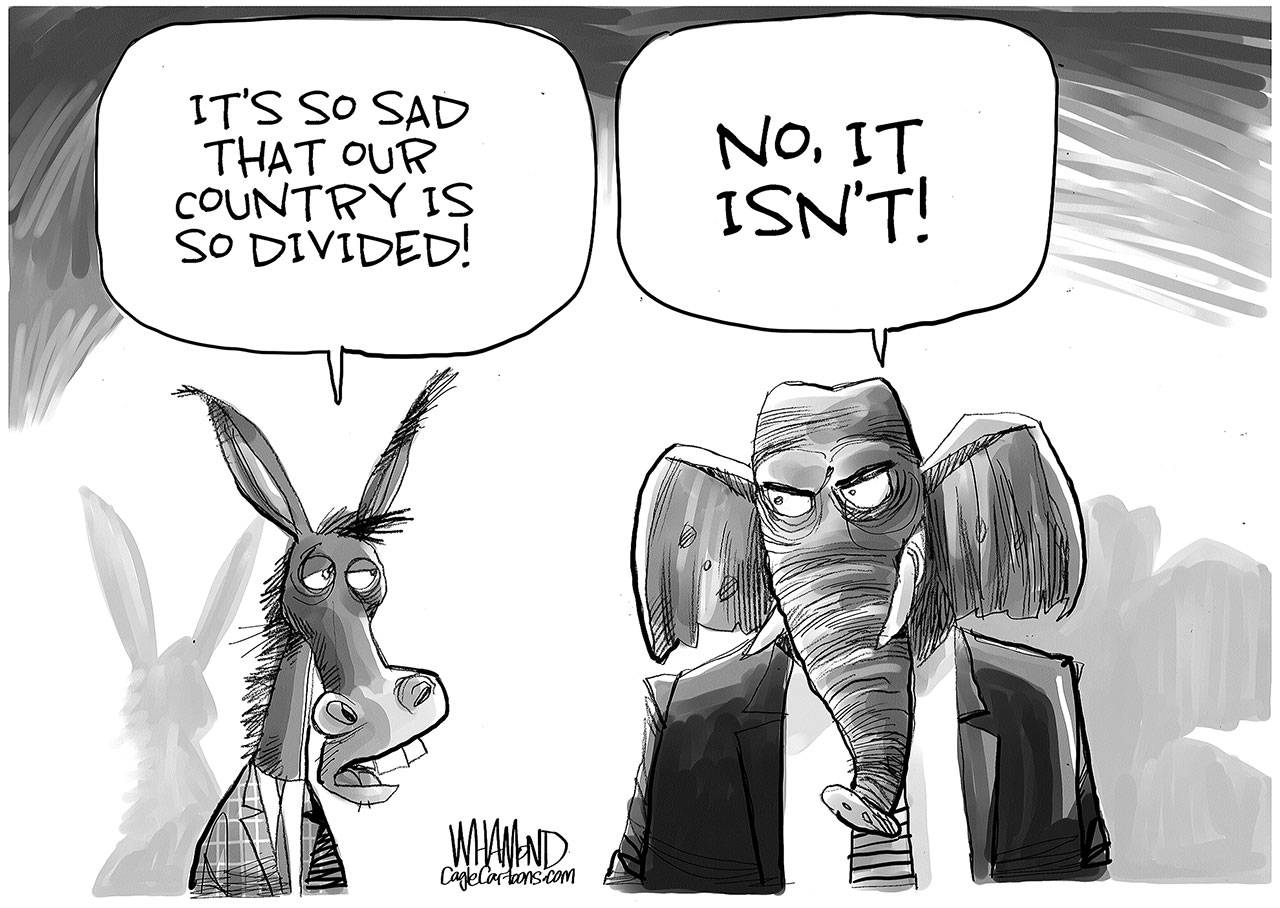By Keith C. Burris
Pittsburgh Post-Gazette
A few months ago I was having lunch with a friend, and we were talking about the country. America seemed divided then. But not like now.
My friend said that if the red and the blues, the proudly unwoke and the woke, the Trump lovers and the Trump haters were divided along strictly geographic lines, as with the war of the North and South, we would have another civil war today.
At the time I thought he was exaggerating — being melodramatic.
I don’t think that today.
Of course the Civil War was essentially fought along geographic lines. But not totally. There were states caught in between and huge swaths of people, in both geographic and sociological segments, that sympathized with the people on the other side of the conflict.
And there is a geographic component to our current division: urban vs. rural. It is true in every state. My wife and I just returned from a road trip that took us to central and rural Pennsylvania. There are very few Biden signs out there. And the Trump signs are as numerous as four years ago — and bigger.
The polls don’t measure enthusiasm. Or reticence.
But my subject is the great divide.
The divide is by geography, age, income, education, class, world views and values.
We divide over heroes and demons, stand-up comics and their jokes, TV shows, movies, music, gender, guns, the Bible, the military and, very much lately, police.
Those Trump signs were not hanging from dorm rooms at Bucknell University. They were on the barns of farmers and in front of home after home on the less-traveled roads in hardscrabble counties and towns.
You don’t often see a Biden sticker on a pickup truck in rural Ohio or Indiana.
“Everyone is scared to death,” said another friend. We dare not get out of our lanes.
On our trip we also visited an old friend in Connecticut, a state bluer than blue. He’d just put a Trump sticker on his car. He told me he expected his vehicle to be vandalized.
He’s a guy who reveres the military and cops. He sees all of Donald Trump’s flaws — all of them. He does not care. He thinks the radical left will take over the Democratic Party, if it has not already. He sees political correctness as an attack not only on free speech but also guys like him — yeah, old white guys. But some of those old white guys are very fine citizens, neighbors, and have served their country and communities selflessly.
This is a man who, when I first met him, pleaded for moderation and, of recent presidents, most admired Jerry Ford.
Portland, Oregon, has radicalized him.
His granddaughters love him and despise the president he admires. They see Donald Trump as the antithesis of the country they hope for — tolerant, free, truly pluralistic as to religion and race and, above all, compassionate. In their America, public health matters more than the economy. So does the environment.
How about my friend’s daughter? She is stuck in the middle — pulled toward both patriotism and egalitarianism. She sees both sides and feels strongly both ways. And she doesn’t want to talk about it.
We are two countries today. And the divisions that go deepest are cultural. If you watch “Blue Bloods” and “NCIS,” you are more likely a conservative, a libertarian or a Republican than a Democrat (and none of that makes you an enthusiastic Trumper). If the death of actor Chadwick Boseman is personal to you, you are more likely a young Bernie supporter than an old white guy.
And you probably don’t know much, if anything, about Thurgood Marshall — a black hero whom Boseman played as well as the Black Panther.
Ignorance is a problem. We need to get back to teaching civics and American history again, instead of “critical theory.”
Information is a problem, too. We don’t know much about what has actually happened in Portland or Minneapolis. A lot of hot commentary is available. Little solid reporting is, and some of the people trying hardest to do it are non-journalists.
We are two countries. And what bothers me is that we don’t know each other very well. We stay in our own echo chambers and refuse to recognize the moral or emotional legitimacy of the people on the other side of the divide.
Is it not obvious that when demonstrators riot they are no longer demonstrating? Or, that when counter demonstrators attempt to directly engage those they oppose, violent results are on the heads of both sides?
The thing is, we don’t need to settle our differences. We need to accept them and find common ground.
I believe a conversation focused on five concepts could uncover, and expand, common ground: from the right, duty and love of country. From the left, pluralism and putting people first — above profit. For all: due process of law.
When I was 14, 15 and 16, my political hero was Sen. Eugene J. McCarthy. One night my parents, who were ardent Roosevelt-Kennedy Democrats, invited a friend who taught law at Ohio State for cocktails. It was a setup. She and her husband, who also came, were Republicans, and the woman was an ardent fan of Richard Nixon’s and had campaigned for him. My mother said, “She has as high a view of Dick Nixon as you do of Gene McCarthy.” This was a small mind-blower for me. Was such a perception, such a different intellectual reality, actually possible?
1968, 1969 and 1970 — those were divisive years. But not like now.
We had a spirited conversation that night. But it was a good one. And we ended the evening as fellow political junkies with respect for each other’s knowledge, as fellow idealists, and as fellow Americans.
Keith C. Burris is executive editor of the Pittsburgh Post-Gazette, and vice president and editorial director of Block Newspapers(kburris@post-gazette.com).



